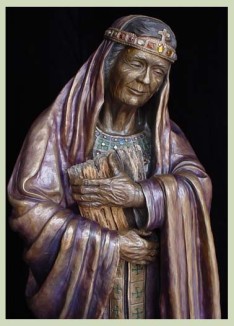
 Summary: St Helen, also known as Helena of Constantinople (c. 250–330). She was the wife of the Roman Emperor Constantius (250-306), and the mother of Emperor Constantine I.
Summary: St Helen, also known as Helena of Constantinople (c. 250–330). She was the wife of the Roman Emperor Constantius (250-306), and the mother of Emperor Constantine I.
She is traditionally associated with finding the relics of the true cross in Jerusalem.
Patrick Duffy traces her story.
British Princess or a tavern maid from Asia Minor?
An English legend would claim that Helen was a British princess, the daughter of Old King Cole, but this is untrue as Constantius her husband had divorced her long before he ever set foot in Britain.
Birth of Constantine
Flavia Iulia Helena was most probably born in the city of Drepanum – later renamed Helenopolis – in Bithynia (modern north-eastern Turkey) in 248/9 AD, the daughter of innkeepers. St Ambrose of Milan (De obitu Theodosii 42) says she was a stabularia, a maid in a tavern or inn. Around the year 270 she met Constantius Chlorus and a few years later gave birth to their son Constantine at Nish in Serbia.
Constantius Divorces Helen
But when in 292 Constantius became Caesar to the Augustus Maximian in the West in the newly formed tetrarchy that ruled the Roman empire, he divorced Helena for political reasons and married Theodora, Maximian’s daughter. From then until Constantine became emperor, Helena’s life was spent in relative obscurity and was probably deprived of the company of her son. Perhaps because of this she is seen as a patron of those undergoing divorce proceedings.
Constantine’s Court in Trier and Rome
Around 306, after the troops of Constantius proclaimed Constantine the successor of his father at York, Helena joined Constantine’s court, probably first at Trier and later at Rome. There are frescoes in the imperial palace in Trier, on which Helena is possibly depicted. When in 312 Constantine had defeated his rival Maxentius in the famous battle at the Milvian Bridge near Rome, Helena probably came to live in Rome. Perhaps to console her for the years of neglect when she was repudiated by her husband Constantius, Constantine gave her as her residence the Sessorian Palace at the south-east corner of the city, part of which survives today as the Basilica of Santa Croce in Gerusalemme. From this time onwards she held a prominent position at the imperial court and in 324 Helena received the title of Augusta.
Pilgrimage to Jerusalem
Constantine’s popularity probably suffered severe damage from the murder in 326 of his son Crispus and his wife Fausta in a palace intrigue. So we find Helen now almost eighty years of age heading off to the East and to Jerusalem in the years 327-328, possibly on a goodwill political visit. Ecclesiastical historian Eusebius, however, describes Helen’s journey as a pilgrimage (Vita Constantini 3.42-47), pointing out its religious aspects, showing Helen as full of religious enthusiasm, visiting the places where Christ’s had walked, caring for the poor and needy and generous in endowing churches to be built on the holy places.

Icon of Ss Constantine and Helen provided by Athanasios Clark and used with permission.
The tradition is that while Helen was in Jerusalem in the years 327-8 she discovered the true cross. She ordered that the 200 year-old Temple of Venus built in the time of the emperor Hadrian be torn down and it was here that the tomb of Jesus and the relics of three crosses were found. Over this she built the Basilica of the Holy Sepulchre.
Veneration of the Cross
The Sermons of Cyril, bishop of Jerusalem, record that remains of the Cross were already venerated in the Church of the Holy Sepulchre at the end of the 340s. Today within the Church of the Holy Sepulchre there are 29 steps leading down to the Armenian Chapel of St Helena, where the relics of cross were said to have been located. The remains of the cross were relocated to Rome, and are on display in the Basilica of Santa Croce in Gerusalemme.
Bethlehem and the Eleona
Helen also went to Bethlehem where she built another church over the cave where Jesus was born. Also back in Jerusalem, she built a third basilica on the Mount of Olives where Jesus ascended into heaven. Constantine financed this building project and called the Ascension church “the Eleona” in honour of his mother.
Helen’s Death
Shortly after her journey to the East, Helen died. She was buried in Rome in a mausoleum Constantine built for her near the Church of Saints Marcellinus and Peter on the Via Labicana. Roma 95
(The porphyry sarcophagus which contained her remains is now in the Vatican Museum).
Image above Ss Marcelinus & Peter’s Church,
Via Labicana. Rome 95
******************************
Memorable Proverb for Today
“Behind every great woman is .. another great woman”
...Kathe Hodges
******************************